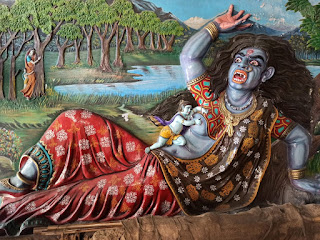One of the primary gods of Hinduism, Shiva, The first Yogi, never
discriminates between good and bad, Suras and Asuras, and also in humans. That
is one of the reasons he is also known as 'Bholenath', The Innocent one. The
Vedas have taught humans to be good even to the wrong ones, as any Human, God,
or Devil can change. It always has been the lack of knowledge to cause the mistakes
leading to evil thoughts and deeds. The only way to deal with other's mentality
is to educate with the right things without hurting the physical body, and that
is one of the primary objectives of Dharma.
Not everyone is blessed with the Intelligence and not every Intellectual is selfless. And as it is said, Lack of brain activity makes a home for evil. Psychologically, that's correct. Always the people with less knowledge were sacrificed for the namesake of religion, borders, and greed. Life can be the one-time opportunity in the universe full of possibilities, one should not waste it on lost and unassured causes. Most of the evil takes place when there is greed and desire to achieve something not meant to. And thus the thought process of an Individual human, God, or an Asura defined him as good and bad.
Asuras, Rakshasas, Daityas, Danavas, and Pisach are popularly known to cause havoc and damage in the world. Very few know the difference between them as most of the kids were taught be fear them. So, here is some information on sorting them out so in case you spot one you should know how to deal.
Daityas :
They were the children of Diti and the sage Kashyapa. The Devas were their half-brothers with whom they fought against as a result of their jealousy. The Manusmṛti classifies the Daityas as good while placing them at a lower level than the Devas:
तापसा यतयो विप्रा ये च वैमानिका गणाः ।
नक्षत्राणि च दैत्याश्च प्रथमा सात्त्विकी गतिः
(12.48. Manusmriti)
Ascetics and hermits, Brāhmaṇas, celestial beings, lunar asterisms, and Daityas represent the first state partaking of ‘Sattva.
The most well-known of the Daityas are Hiranyakashipu, Hiranyakṣa, Prahlada, and Bali.
Daityas belonged to the Daitya kingdom, hence fought to protect it. Their political powers increased as they were granted boons by Brahma or Śiva or when they have performed Yajnas such as the Aswamedha, as in the case of Bali and Mahisa.
Asuras:
In the churning of Ocean, Amrita, the elixir of life, was unequally
distributed by deceiving the Daityas and no Amrita was offered to them in real.
And so they are called Asuras. In some text, the Daityas who refused Varuni
(Goddess of Wine) are called Asuras. Wine is a Liquor which emerged from
Kshirsagar (Ocean of Milk), which at the time was also called Sura.
Asuras are described in texts as powerful superhuman demigods with mostly bad qualities. The good Asuras are called Adityas and are led by Varuna. In the earliest layer of Vedic texts, Agni, Indra and other gods are also called Asuras, in the sense of them being "lords" of their respective domains, knowledge, and abilities.
Some of the famous Asuras are :
- Madhu
and Kaithba.
- Ravan.
- Vritra.
- Meghnatha.
- Hiranyakashipu.
- Raktabija
More on Asuras: Here
Rakshasa:
Rakshasa, in
mythology, a type of demon or goblin. Rakshasas can change their shape at will
and appear as animals, as monsters, or in the case of the female demons, or as
beautiful women. They are most powerful after the sunset, particularly during
the dark period of the new moon, but they are dismissed by the rising sun.
They despise sacrifices and prayer. Most powerful among them is their
king, the 10-headed Ravaṇa (q.v.). Putana, a female demon (Rakshasi), is well
known for her attempt to kill the infant Krishna by offering him milk from her
poisoned breast; she was, however, sucked to death by the god. While some say
that Krishna bite-off the nipple so the aunt Putana had to come in her original
form.
Not all rakshasas are equally evil; some are more alike yakshas,
or yakṣas (nature spirits), while others are like asuras, the
traditional opponents of the gods. The term Rakshasa, however, generally
applies to those demons who haunt cemeteries, eat the flesh of men, and drink
the milk of cows dry as if by magic.
Some of the famous Rakshasas:
- Maricha
- Shurpanakha
- Putana
- Ravana
Pisacha:
Pisacha or Pisach are the flesh-eating
demons who have excess veins and pointed, red eyes. Some texts do mention of
them being the offsprings of Sage Kashyapa and Krodhavasa (Daughter of Daksha).
Piśācas like darkness and traditionally are depicted as haunting cremation
grounds along with other monsters like Bhutas(Ghosts) and
Vetalas(Betaal).
Pisach supposedly possesses the paranormal ability to shapeshift and pretend any forms at will and may also become invisible. They can feed on human energy. Sometimes, they possess human beings and alter their thoughts, and the victims are distressed with a variety of sicknesses and abnormalities like insanity.
Hinduism believes chanting Hanuman Chalisa can help getting rid of them.
In early literature, the Dardic people in the north of Kashmir were referred to as Pisaca and Dardic languages were called Paisaci. They are said to have been descendants of Prajapati Kashyapa.
Some Famous Pisachas:
- Betaal,
Vetaal
- Pey
- Peymakilir






Comments
Post a Comment